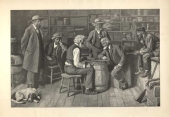The Checker Maven
The World's Most Widely Read Checkers and Draughts Publication
Bob Newell, Editor-in-Chief
Published every Saturday morning in Honolulu, Hawai`i
Noticing missing images? An explanation is here.
An Interview With ACF President Alan Millhone

The Checker Maven had the privilege of interviewing Mr. Alan Millhone, President of the American Checker Federation (ACF), via email. Mr. Millhone was kind enough to give us many insights into his own life, his checker career, and his aspirations as ACF President.
Checker Maven: Tell us a little about your background.
Alan: I am married to Victoria Lee Millhone and have a grown daughter, Joclaire, and her husband Thomas and our three grandsons, Forest, Solomon and David. I was born in Parkersburg, W.Va. in 1948 and have lived all my life in Belpre, Ohio. I graduated from Belpre High School in 1966. My 9th and 10th grades were spent at Fork Union Military Academy in Fork Union, Va. I attended 4 years at Franklin University in Columbus, Ohio and earned a B.S. in Business Administration. After college I was drafted into the U.S. Army in 1970, and spent time in the US and in Korea. (I was) Honorably Discharged in 1972. My father was a building contractor in Belpre since 1955 and I helped him in my school years, summers and while I was in college. After the Army I began full time work as a builder/remodeler and do that to this day in the Belpre,Ohio area. Aside from being ACF President I am also the local Board President for Habitat for Humanity.
Checker Maven: When and how did you become interested in checkers?
Alan: I used to play my father when I was little and he would get me into little 2x1 shots, etc. That must have been the early beginning to learn more about the game. In high school I was tutored by the late Walter Kaneff of Constitution, Ohio. While attending college in Columbus, Ohio I met and was mentored by the late Mr. B.T. Shafer. He loved problems and would always have one set up for me to solve when I visited his home in New Albany, Ohio. He taught me early on to never 'touch' the pieces and always try to 'sight solve' and visualize solutions to board problems.
Checker Maven: What made you interested in a leadership role in checkers, and how did it come about that you became ACF president?
Alan: In 1970 I left checkers when I entered the Army and forgot about the game till around 1999. That Christmas I was visiting our daughter in Charlotte,N.C. and her husband Tom had a computer and indicated he knew I played checkers years back. he told me I could play on line which fascianted me as to date I had never touched a computer. He set me up with a nickname and got me onto MSN gaming zone. I played the afternoon and was 'hooked' once more. At the Pennsylvania Open I met Mr. Alexander Moiseyev and we chatted in my room one evening. Later on I met him again at the Ohio Tournament and he told me he liked what he saw in me and offered to be my campaign manager if I would run for ACF President. I ran as an unknown after my 30 year absence and won over Mr. Charles Walker by a mere 7 votes!
Checker Maven: How would you characterize the state of "organized" checkers today? How does that compare with the past and what are the hopes and prospects for the future? How do you think the ACF will do in years to come?
Alan: Checkers and the ACF has been on the decline since the advent of television in the early 60s. For the game to survive and for the ACF to remain we have to attract and keep young players. The ACF needs a corporate sponsor to help our youth. My goal is to find that sponsor and have them join ranks with the ACF to promote one of the finest mind sports ever conceived by man. The ACF cannot continue to do 'business as usual' or we will perish in time. It is time for different thinking and for the infusion of new ideas if we are to survive in today's video oriented world.
Checker Maven: What do you think the effects of computers have been on the game of checkers? Do you think checkers will ever be solved, and what difference do you think that might make, if any?
Alan: Computer programs have been a blessing to analysts and those who want to 'hammer' out new lines of play. Checkers may be solved one day, but that will not make me another Tinsely when it does become solved. The computer/internet lets players from all over the globe interact and chat while playing on a variety of playing sites. Even the mail players are using the internet now to play mail games where it used to take months via snail mail. Many contend that computer programs have killed mail play.
Personally I love going to different tournaments and meeting and playing a variety of players from all over the USA and abroad. I consider checker players as my second family.
Checker Maven: What about the effect of computers on correspondence play?
Alan: I have never played any correspondence checkers, but realize that many new lines of play come from the mail players and the lines they have 'hammered' out from those games. Checkers used to be a game of mental analysis. My good friend Mr. Karl D. Albrecht will be noted in checker history as one of the greatest analyists who ever played the game. However today one can program in the moves you want and go to bed and let the computer program do the rest. Programs to me have taken the human element out of the game to some degree.
Checker Maven: What would you say to those who think that checkers is boring, or just a kid's game?
Alan: Most people play 'skittle' checkers and never scratch the surface of the game nor ever learn to appreciate its deep beauty . I have had many tell me checkers is a game of luck; well, luck comes to those who are well prepared. The late and great football coach, Mr. Vince Lombardi once remarked , "Luck is the residue of preparation" . The great William F. Ryan once remarked that one should avoid those who do not appreciate the deep intricacies of checkers. Yes, checkers is a game you can learn to play in a few minutes (how pieces move, taking jumps, movement of King,etc.) but then spend the rest of your life attempting to master.
Checker Maven: You often call yourself an "average" player but your tournament results are quite outstanding. Do you have any ambitions such as winning titles or being a grandmaster level player?
Alan: My goal is to improve my play over time and to see my rating inch up a little now and then. I know just enough about checkers to now realize how little I actually know about the game. I fear no player and love to play the best at any opportunity. To play better you have to play the better players.
Checker Maven: What moments in checkers are you personally most proud of?
Alan: In the late 60s while in college I organized two simultaneous exhibitions for Mr. Tommie Wiswell and Mr. Newell W. Banks. Both men also stayed at my home years ago. The great Marion Tinsley was a house guest years ago on several occasions. Most recently getting to play on the USA International Team vs. GB, Ireland and Scotland was a highlight in my life. I went to observe the match and ended up playing 7 rounds. A fine book commemorating this match will be published soon.
Checker Maven: What advice would you give to the young or up-and-coming player, or to the plain-old ambitious checkerist?
Alan: As Dr. Gerry Lopez likes to admonish, " Knowledge is Power." You can't beat the player who is well 'booked' on published play and has crossboard ability as well. Attend and enter tournaments as you can, get yourself a good program to play against on your computer, and build yourself a good checker library of reference books. I like Mr. Fortman's Basic Checkers, Dr. Shuffett's and Tommie Wiswell's America's Best Checkers , and Mr. Alex Moiseyev's new book Sixth .
Checker Maven: Anything else?
Alan: The American Checker Federation is always looking for new members and we publish six bulletins a year full of checker news, games, etc. Visit our web site at www.usacheckers.com for more information.
Our thanks to Mr. Millhone for granting us this information-filled interview.![]()
Allan Millhone Plays Checkers
To accompany our interview with American Checker Federation President Alan Millhone, we present these two fine games played by Mr. Millhone in the 2006 District 6 Checker Tournament, against no less an opponent than World Champion Alex Moiseyev. The games have been expertly annotated by Dr. Richard Beckwith.


Games from 2006 District 6 Tournament
Game 1
Black: Alan Millhone
White: Alex Moiseyev
10-14 22-18 11-16 26-22---A 8-11---B 22-17---C 16-20---D 17x10 6x22 25x18 9-14---E 18x9 5x14 29-25 7-10 25-22 3-7 30-26 11-15 24-19 15x24 28x19 4-8 22-17 7-11 17-13 11-16 26-22 8-11 22-18---F 1-5 18x9 5x14 13-9 11-15 9-5 15x24 23-19 16x23 27x9 12-16?---G 5-1 10-14 1-6 14-18 6-10 18-22---H 10-15 22-25---I White Wins.
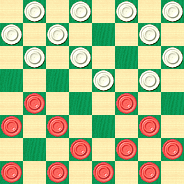
BLACK
Black to play (note D)
B:W32,31,30,29,28,27,25,24,23,21,18,17:B16,14,12,11,9,7,6,5,4,3,2,1.
WHITE
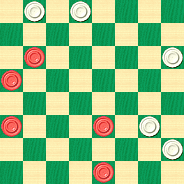
BLACK
Black to Play and Draw (note G)
B:W32,31,21,9,5:B24,20,12,10,2.
A---Also reached from 11-16 23-18 10-14 26-23 same.
B---Natural, but a very weak reply, unless one has a prepared defense. In fact, Solid Checkers gives 8-11 a question mark. The two usual alternatives are 7-10 and 16-20. The 16-20 move permits 22-17 7-10 and the option of a good off-Bristol-Cross variation with 17-13 now, as shown in Basic Checkers Op. # 120 trunk, the line where 24-19 is held back. To keep more options open, 7-10 has been suggested (instead of 16-20 or 8-11), then 22-17 and now black has the option of 16-20 (into the same line just mentioned) or the 16-19 bust.
C---A good move by the world champ, whereas 24-19 allows 16-20 and back into a standard Bristol-Cross.
D---See diagram prior to 16-20. Alan has previously played the published 7-10 here (vs. L. Cowie in 2005 OH Ty.), but I like this 16-20 better! Both BC and SC give only 7-10 25-22 3-7 31-26 9-13 18-9 5-14 23-19 with white powerful.
E---While this will get through to draw, black also has 7-10 as a defense (perhaps new?). Continue with 24-19 (or 29-25 3-7 24-19 11-15) 11-16 and into an old secondary Bristol-Cross defense often used by another Ohio player, Louis Cowie (and occasionally by your annotator as well). This position normally arises from 11-16 23-18 16-20 24-19 10-14 26-23 8-11 22-17 11-16 17x10 6x22 25x18 7-10.
F---13-9 (liked by programs, but not necessarily better) 11-15 32-28 15x24 28x19 1-5 31-26 2-7 22-18 14-17 21x14 10x17 9-6 17-21 6-2 7-10 2-6 10-14 18x9 5x14 26-22 21-25 6-2 (or 6-10 14-18 22x15 25-30 draw) 25-30 2-6 and now pitching the man on 14 is necessary, and then the king can attack the elbow to draw. rcb
G---Sets up a “breeches” problem later. Instead, 10-15 5-1 15-18 31-26 12-16 (now OK with 31-26 played) 1-5 2-7 9-6 16-19 5-9 7-11 (whoops! 18-23 draws this game) 32-27 & 9-14 WW, T. Laverty – R. Jones 1987 Florida Open
H---Now black cannot advance to 23 to set up a trade due to the king advance with 10-15 & 15-19.
I---The scoresheet ended here, but the position will win for white given the three stranded black pieces in front of the double corner, as well as additional white kings “on the way.”
Game 2
Black: Alex Moiseyev
White: Alan Millhone
10-14 22-18 11-16 25-22 16-20 29-25---A 8-11---B 18-15---C 11x18 22x15 4-8---D 26-22---E 7-10 31-26 10x19 24x15 6-10---F 15x6 1x10 22-18---G 8-11 28-24 10-15 25-22 2-7 23-19 14x23 19x10 7x14 26x19 9-13 22-18 14x23 27x18 20x27 32x23 11-16 18-15 16-20 15-11 20-24 23-18 24-27 18-15 27-31 11-7 3x10 15x6 31-27 6-2 5-9 2-6 9-14 19-15 14-18 6-9 18-22 15-10 27-23 21-17 Drawn.
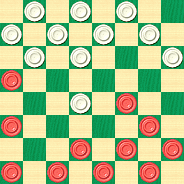
BLACK
Black to Play (note D)
B:W32,31,30,28,27,26,25,24,23,21,15:B20,14,12,9,7,6,5,4,3,2,1.
WHITE

BLACK
Black to play (note F)
B:W32,30,28,27,26,25,23,22,21,15:B20,14,12,9,8,6,5,3,2,1.
A---A natural development, but 24-19 is preferred, or taking the Bristol-Cross a move earlier, as Alex did in Game 1. Historically, 29-25 has thrown the advantage back to black.
B---This position is also reached by either 11-16 22-18 16-20 25-22 8-11 29-25 10-14 or by 12-16 22-18 16-20 25-22 8-12 29-25 10-14.
C---24-19 is known to be “bad” by well-versed players due to the bind, but narrow draws do exist. Continue: 11-16 (4-8 19-15 7-10 27-24 draws) 18-15 4-8 28-24 7-10 15-11* (instead of 22-18 and Ryan’s “Pickle Barrel trap” given in Solid Checkers) 8x15 23-18 14x23 27x11 16x23 26x19 20x27 31x24 10-15 draws, Wyllie-Barker, 1882, from 11-16 24-19 8-11 opening.
D---See diagram prior to 4-8. There are three established options here, with 7-10 (Var. 1) being best for black, and a review of the OCA database reveals the majority of these games have resulted in black wins. The 4-8 played here has historically favored white. The third option is 9-13 (Var. 2), as given in Basic Checkers Opening #116 trunk.
E---Well played by Alan, leaving black to use care to draw. 24-19 instead is wanted, then 7-10 leads to the “bad stuff” for white in Var. 1.
F---See diagram prior to 6-10. Not 14-18? 23x14 9x18 21-17* (instead of 26-23 3-7 23-14 6-10 draw, Gonotsky-Lieber, 1928) 2-7 26-23 6-9 23x14 9x18 30-26 1-6 26-23 12-16 23x14 7-10 14x7 3x19 25-21* 5-9 22-18 9-13 17-14 13-17 18-15 17-22 21-17 22-26 17-13 8-12 27-24 20x27 32x23 26-31 23-18 31-26 14-9 26-23 9x2 23x14 15-10 WW, J. Hanson.
G---Leads to a quiet draw, likely unpublished. (And any quiet draw for an “average” player against a world champ is a good one!) The usual press is with 23-18 14x23 27x18 9-13 18-14 10x17 21x14 2-6 22-18 6-10 14x7 3x10 26-23 8-11 23-19 20-24* 19-16 11x20 28x19 to a draw, Rubin-Hunt 1934 Am. Ty., from 12-16 22-18 16-19 opening.
Var. 1 7-10 24-19---1A 4-8 27-24---1B 20x27 31x24 9-13 (2-7 also strong) 24-20 3-7 25-22 5-9 30-25!---1C 1-5 22-18 14-17 21x14 10x17 19-16 12x19 23x16 17-21 16-12 21x30 12x3 30x14 3x1 to a strong black ending, but probable draw. RCB.
1A---Very weak, now that the draws of note C have been bypassed. White should play the 25-22 10-19 23-16 pp draw.
1B---Basic Checkers also mentions 26-22 and 23-18, but both are given to lose. The 27-24 is the best bet to draw, although the line should be avoided altogether.
1C---Instead of 22-18 or 32-27 in BC, Op 116 note F1.
Var. 2 9-13 26-22---2A 5-9---2B 22-18---2C 7-10 30-26*---2D 10x19 24x15 3-7 25-22 7-10 15-11 12-16---2E 22-17 13x22 26x17 16-19 23x16 14x23 27x18 10-14 17x10 6x22 11-7 Drawn. RCB.
2A---Or 24-19 4-8 28-24 as in BC, Op #116 trunk.
2B---Or 13-17 & 6-9 draws, which may be best if the upcoming 30-26 improvement is feared.
2C---31-26? 7-10 22-18 10x19 24x15 3-7 25-22 (starred in BC, but appears to lose given upcoming correction) 7-10 23-19 14x23 27x18 10-14 26-23 20-24 15-10 6x15 18x11 24-27 19-15 13-17* (correcting 1-5 to draw in BC) 22x6 1x26 30x23 12-16 28-24 27-31 24-19 16-20 19-16 31-27 BW. RCB.
2D---Avoiding 31-26 and back into the previous note. White is now better after 30-26.
2E---10-15 28-24 12-16 24-19 15x24 18-15 16-19* 23x16 14-18 15-10 18x25 32-28 6x15 28x10 25-30 26-23 2-6* 10-7 6-10 7-2 10-14 2-7 1-5 16-12 30-26 31x22 14-17 21x14 9x25 Drawn. RCB.
And now, as a special bonus for those of our readers who have come this far, we present a game in which we know Mr. Millhone takes great pride; a game in which he made a draw against the greatest checker player of all time, Dr. Marion Tinsley.


Black: Marion Tinsley
White: Alan Millhone
11-15 23-18 8-11 26-23 10-14 30-26 6-10 24-19 15x24 27x20 2-6 28-24 10-15 32-28 7-10 22-17 15x22 25x18 10-15 17x10 15x22 26x17 6x15 29-25 9-13 17-14 15-18 24-19 18x27 31x24 3-7 25-22 1-6 19-16 12x19 24x8 4x11 22-18 13-17 28-24 6-10 24-19 17-22 21-17 22-26 17-13 10x17 19-15---A Drawn.
A---The only move to draw, and a fitting conclusion to a game played without even the smallest of errors.
Mr. Millhone modestly calls himself "an average player" but these games show that if this is "average" play, wouldn't we all like to be "average" ourselves!![]()
The Lost Soul
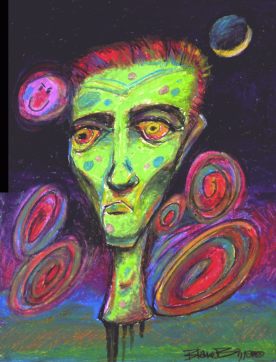
This month's speed problems come from actual play on the GoldToken turn-based game site. The first one is a nice win crafted by a rather skilled player who calls himself Lost Soul for reasons to which we are not privy; but this skilled player is anything but lost when playing over the board! The problem is in the easy category, and we're allowing you 15 seconds to solve it.
The second problem is a neat victory gained by Larry OTC. Again, we're not sure what "OTC" means, but we doubt that it's "over the counter"; could it be "one terrific checkerist"? Only Larry knows for sure; but we rate the problem as medium in difficulty and give you 60 seconds to find the right moves.
October Speed Problem 1 (easy)
October Speed Problem 2 (medium)
Don't lose your own soul over these problems; salvation is at hand by simply clicking on Read More to see the solutions.![]()
Let's Play Checkers

While we're a bit behind schedule, we still plan to release our electronic edition of Richard Pask's book Key Endings by the end of 2006. And, we've previously noted that in 2007 we'll be starting on the very ambitious project of a full electronic reissue of Mr. Pask's Solid Checkers.
However, we've chosen the next book to appear after Key Endings. We're very pleased to announce that you can expect a newly-typeset, electronic edition of Ken Grover and Tom Wiswell's enduring classic, Let's Play Checkers, some time in the first half of 2007 (we're estimating a June 1 release date).
Let's Play Checkers is one of the best selling checker books of all time. Long out of print, this 1940 book still commands respect over 65 years later. It's one of the first of very few checker books to ever present the "repertoire" concept, well-known to chess players, of playing a selected set of opening moves which have been carefully studied.
The "repertoire" concept of course applies only to freestyle or "go as you please" checkers, but as this is what is played by many an average checker fan, Let's Play Checkers is of great value and interest. Rounded out with formation or "landing" studies, endgame studies, and a great collection of problems, it isn't hard to see why this book became a classic best-seller.
Of course, as is the case with all of our electronic reissues, it will be available absolutely free of charge. We only ask that you too support and play our great game of checkers!![]()
The Bear Trainer

Despite Brian Hinkle's generous $100 prize offer, no correct solutions were received to his admittedly difficult Bear Claw problem, and the prize offer has now expired. However, we still would like to see someone solve the problem prior to our publication of the solution, and to that end, Brian has sent us what he calls a "trainer" position.
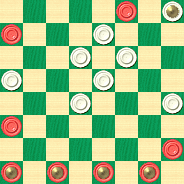
WHITE
White to Play and Draw
W:W20,18,15,13,11,10,7,K4:BK32,K31,K30,K29,28,21,5,3.
Here are Brian's comments on this position:
"There are 4 solutions to the Bear Trainer position.
- If you can find one solution then you may be a minor player.
- If you can find two solutions, then you may be a major player.
- If you can find three solutions then you may be a master player.
- And, if you can find all four solutions, then you may become the next world champion checker player!"
We can't say if Brian's rating system is accurate, but we can say that you should give the position a try, and then complete your training by clicking on Read More for Brian's solutions.![]()
Brilliant

In one of Tom Wiswell's many fine books, Mr. Wiswell published a number of situations which he referred to as "checker brilliancies." We have to agree with him, as in these settings, the winning player invariably comes up with a move or a sequence that is, well, brilliant, both in concept and execution.
Today, we challenge you to match wits with James P. Reed, in a game played back in 1889 against Charles F. Barker. The move Mr. Wiswell calls "Barker's Blunder" allowed Mr. Reed to find an astounding win. Here's the run-up and the game position:
| Black: | Charles F. Barker |
| White: | James P. Reed |
| 10-14 | 22-17 |
| 7-10 | 17-13 |
| 3-7 | 25-22---A |
| 14-17 | 21-14 |
| 9-25 | 29-22 |
| 10-14---B | 24-19 |
| 6-10 | 22-18 |
| 14-17 | 27-24 |
| 1-6 | 19-15 |
| 10-19 | 24-15 |
| 12-16---C |
A---24-20 can be played here.
B---This move doesn't lose, but it could be argued that 11-15 or even 10-15 is better.
C---This is the "blunder" that loses.
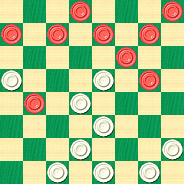
WHITE
White to Play and Win
W:W13,15,18,23,26,28,30,31,32:B2,4,5,6,7,8,11,16,17.
Can you match Mr. Reed for brilliance and find the winning move? We'll warn you, it's really something and takes a truly skilled player to find. How about correcting Mr. Barker's "blunder" and instead demonstrating a draw?
Work it out and then click on Read More to see if your play really shines.![]()
Double Barreled Action

It's double barreled action in today's installment of Checker School, as we continue to bring you interesting situations from Boland's Famous Positions in the Game of Checkers.
Let's look at one that you might find challenging. It's by F. W. Drinkwater, and the solution contains a number of "star" moves. (A "star" move is a move for which there is no alternative, and it's often rather hard to spot.) Fire away!
WHITE
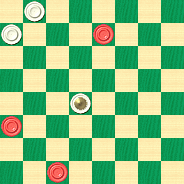
BLACK
Black to Play and Draw
B:W28,32,K15:B3,12,26.
If you missed the target on that one, prime the second barrel and try this easier position, which arises from a variant of the first problem's solution. It's credited to A. Sinclair.
BLACK
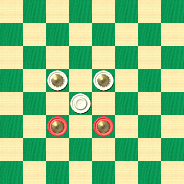
WHITE
Black to Play, White Wins
B:WK14,K15,18:BK22,K23.
No matter how well you've aimed, though, you won't get shot down. Trip the mouse trigger on Read More and score a bullseye with Ben Boland's solutions, illustrative game, and detailed notes.![]()
Uncle Ben's Porch

As I made my way down the sidewalk, a trace of early morning coolness still lingered in the air, but the temperature was on the rise and I knew that another hot and humid Florida day was ahead. But it was still, in every respect, a fine Saturday morning, a day free from school and a morning free of chores; and on many a Saturday morning such as this one I would make my way over to Uncle Ben's porch.
He would always be waiting for me there, usually with an ice-cold pitcher of fresh-made lemonade or sometimes sweet tea. And his checkerboard would be set up and ready.
It was no different this morning. I called out a greeting to him. "Mornin', Uncle Ben!" Of course, he wasn't really my Uncle, but we all called him that. We didn't know all that much about him, just that he had lived in the New York City area until his retirement, and that he was a famous checker expert who had written a lot of books.
"Mornin', Tommy," he replied. "Ready for a little checkers today?" Uncle Ben had that wry grin that told me he was expecting me this morning and that he was ready with something new to challenge me.
"Sure am", I answered as I climbed up the old stairs to the porch. Uncle Ben had been teaching me checkers and he told me I was making good progress. I thought so, too, judging by the number of games I was winning in the schoolyard, but then Uncle Ben would always encourage me to learn more and do better.
"What do you think of this one, Tommy?" he asked. I pulled up a chair and looked at the checkerboard. Uncle Ben had set up this position:
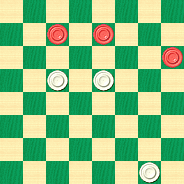
WHITE
White to Play and Win
W:W32,15,14:B6,7,12.
"Can you work it out, Tommy?" Uncle Ben inquired of me, "It isn't as hard as some others, you know!" Uncle Ben's idea of "hard" was a little different than mine, I can tell you, but I wasn't going to quit without giving it a good try.
Well, I sure had to spend a few minutes thinking. After a bit, Uncle Ben asked, "Would a glass of lemonade help?" He didn't wait for my reply but went ahead and poured me a tall, brimming-full glass of his delicious, cold lemonade. He always seemed to know just the right time to offer refreshments or give a hint. He was a natural-born teacher and I often wished my teachers at school had his ways.
I took a few sips, thought a little more, and suddenly the idea came to me. Another few moments and some additional mental effort convinced me that I was on the right track. Finally, I offered, "Yep, Uncle Ben, I think I'm ready."
"OK, then, young man, show me how it's done!" he exclaimed.
"Well, here's my idea," I said, as I started to shift the checkers.....
What solution would you have proposed to Uncle Ben? Unfortunately, you'll have to make your own lemonade, but when you're ready, click on Read More for the solution, commentary, a sample game, and over two dozen fully-diagrammed additional examples of this common and important checker theme.![]()
Labor Day Race

This article will be published on Labor Day weekend, a time to kick back, relax, enjoy a beverage, and recognize the ordinary working guy and gal; the people who through their daily hard work and perseverance make America great. We know that many of these folk are checker players, as checkers is the mind sport of the common man; and today we salute all of you with our September speed problems.
September Speed Problem 1 (easy enough but a bit odd; one minute)
September Speed Problem 2 (moderately easy; two minutes)![]()
The Twelve Move Sack

We continue to electronically reprint Willie Ryan's unmatched classic, Tricks Traps & Shots of the Checkerboard, in tantalizing monthly installments. This month, we feature a twelve move debacle and a thrilling triple action shot. Willie himself explains.
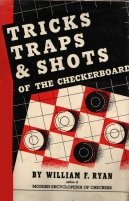
A Twelve-Move Sack
It takes only one bad move to make a total wreck out of a good healthy position, as the reader will note from a cursory examination of this well-known 12-move mop-up. White's play up to A is sound enough; but with 21-17, black cuts loose with a withering blast of fireworks. Proceed:
10-14 24-19 11-16 28-24 16-20 19-15 9-13 23-19 7-10 32-28 14-18 21-17---A, forming the diagram.
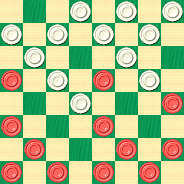
BLACK
Black to Play and Win
B:W15,17,19,22,24,25,26,27,28,29,30,31:B1,2,3,4,5,6,8,10,12,13,18,20.
A---This is where white misses the boat. The following is correct to draw: 26-23, 2-7, 23-14, 10-26, 30-23, 8-11, 15-8, 4-11, 31-26, 6-10, 19-16, 12-19, 24-6, 1-10, 26-22, 10-14, 22-17, 13-22, 25-9, 5-14, 29-25, 11-15, 25-22, 7-10, 22-17, 15-18, 17-13, 18-22, 13-9, 22-26, 9-6, 10-15, 6-2, 15-18. Wm. F. Ryan.
An Old Familiar
The following catch is well-known to all expert players, and is particularly useful in crossboard play, because it arises from several openings. In this example, a triple action shot does the trick, white executing three separate double jumps in succession.
9-13 23-19 6-9 27-23 9-14 22-18 11-15 18-11 8-15 23-18 14-23---A. See the diagram.
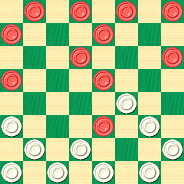
WHITE
White to Play and Win
W:W19,21,24,25,26,28,29,30,31,32:B1,2,3,4,5,7,10,12,13,15,23.
A---The wrong jump. The correct play is: 15-22, 25-9, 5-14, 19-16, 12-19, 24-6, 1-10, 29-25, 4-8, 25-22, 8-11, 28-24, 11-15, 32-27, 7-11, 26-23, 3-8, 30-26, 14-18, 23-7, 15-19, 24-15, 11-25, ending in a draw.
Don't get sacked yourself; clicking on Read More will bring you solutions and commentary.![]()
The Checker Maven is produced at editorial offices in Honolulu, Hawai`i, as a completely non-commercial public service from which no profit is obtained or sought. Original material is Copyright © 2004-2025 Avi Gobbler Publishing. Other material is public domain, as attributed, or licensed under Creative Commons. Information presented on this site is offered as-is, at no cost, and bears no express or implied warranty as to accuracy or usability. You agree that you use such information entirely at your own risk. No liabilities of any kind under any legal theory whatsoever are accepted. The Checker Maven is dedicated to the memory of Mr. Bob Newell, Sr.

